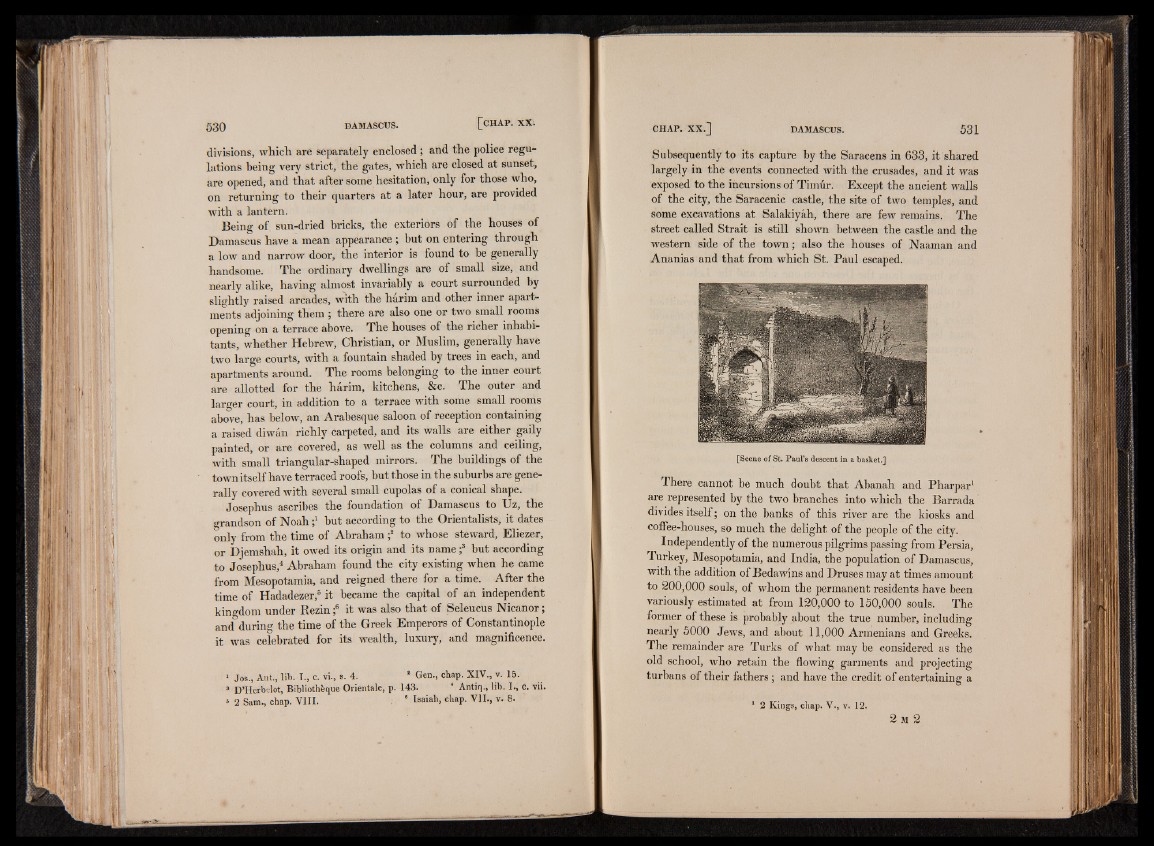
divisions, which are separately enclosed ; and the police regulations
being very strict, the gates, which are closed at sunset,
are opened, and that after some hesitation, only for those who,
on returning to their quarters at a later hour, are provided
with a lantern.
Being of sun-dried bricks, the exteriors of the houses of
Damascus have a mean appearance ; but on entering through
a low and narrow door, the interior is found to be generally
handsome. The ordinary dwellings are of small size, and
nearly alike, having almost invariably a court surrounded by
slightly raised arcades, with the harim and other inner apartments
adjoining them ; there are also one or two small rooms
opening on a terrace above. The houses of the richer inhabitants,
whether Hebrew, Christian, or Muslim, generally have
two large courts, with a fountain shaded by trees in each, and
apartments around. The rooms belonging to the inner court
are allotted for the hârim, kitchens, &c. The outer and
larger court, in addition to a terrace with some small rooms
above, has below, an Arabesque saloon of reception containing
a raised diw.Vn richly carpeted, and its walls are either gaily
painted, or are covered, as well as the columns and ceiling,
with small triangular-shaped mirrors. The buildings of the
town itself have terraced roofs, but those in the suburbs are generally
covered with several small cupolas of a conical shape.
Josephus ascribes the foundation of Damascus to Uz, the
grandson of Noah but according to the Orientalists, it dates
only from the time of Abraham ? to whose steward, Eliezer,
or Djemshah, it owed its origin and its name ;3 but according
to Josephus,4 Abraham found the city existing when he came
from Mesopotamia, and reigned there for a time. After the
time of Hadadezer,5 it became the capital of an independent
kingdom under Rezin f it was also that of Seleucus Nicanor ;
and during the time of the Greek Emperors of Constantinople
it was celebrated for its wealth, luxury, and magnificence.
1 Jos., Ant., lib. 1.1 c. vi., s. 4. * Gen., chap. XIV., v. 15.
3 D’Herbelot, Bibliothèque Orientale, p. 143. " Antiq., lib. I., c. vii.
» 2 Sam., chap. VIII. , Msaiah, chap. VII., v. 8.
Subsequently to its capture by the Saracens in 633, it shared
largely in the events connected with the crusades, and it was
exposed to the incursions of Timur. Except the ancient walls
of the city, the Saracenic castle, the site of two temples, and
some excavations at Salakiyâh, there are few remains. The
street called Strait is still shown between the castle and the
western side of the town ; also the houses of Naaman and
Ananias and that from which St. Paul escaped.
[Scene of St. Paul’s descent in a basket.]
There cannot be much doubt that Abanah and Pharpar1
are represented by the two branches into which the Barrada
divides itself; on the banks of this river are the kiosks and
coffee-houses, so much the delight of the people of the city.
Independently of the numerous pilgrims passing from Persia,
Turkey, Mesopotamia, and India, the population of Damascus,
with the addition of Bedawins and Druses may at times amount
to 200,000 souls, of whom the permanent residents have been
variously estimated at from 120,000 to 150,000 souls. The
former of these is probably about the true number, including
nearly 5000 Jews, and about 11,000 Armenians and Greeks.
The remainder are Turks of what may be considered as the
old school, who retain the flowing garments and projecting
turbans of their fathers; and have the credit of entertaining a
1 2 Kings, chap. V., v. 12.
2 m 2